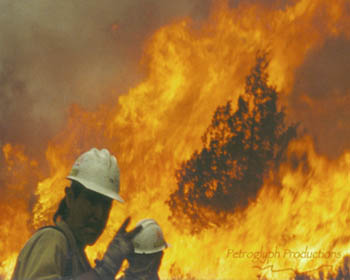![[MetroActive Movies]](http://metroactive.com/movies/gifs/movies468.gif)
[ Movies Index | Show Times | Santa Cruz | MetroActive Central | Archives ]
Burning Men
A local filmmaker documents an elite American Indian firefighting crew
By Tai Moses
EVERY SUMMER, crews of firefighters are dispatched to fight the blazes that erupt in the nation's driest, most fire-prone wildernesses, from California to Florida. But how many Americans, mesmerized by news reports of anonymous acts of heroism on the fire line, know that 70 percent of these wildland firefighters are American Indians?
It was this shameful oversight that motivated Scotts Valley filmmaker Ismana Carney to make her documentary, Chief Mountain Hotshots: Firefighters of the Blackfeet Nation.
"Hotshots" are the ground troops, the infantry of the firefighting machine. It's hard, dirty, dangerous work, done with chainsaws and hand tools. The Chief Mountain hotshots, based on the Blackfeet Indian reservation in north-central Montana, have earned a reputation for being one of the most tenacious hotshot crews in the country.
When I express incredulity at the 70 percent figure, Carney laughs heartily.
"That's the whole point of my film--you and everybody else doesn't know that. The thing that's so extraordinary is that we still live in a nation that can so blindly omit those amazing statistics.
"When I first decided I was going to do this I watched every single fire show that PBS and Discovery put out--about seven shows--and in all of those shows I saw one Indian face, and of course it was the most unimportant face. And so in my show we see only Indian faces and we see one white face."
Carney, who has produced or co-produced two other documentaries about Native American culture--Linda Yamane: California Indian Basket Weaver and We Pray With Tobacco, uses an oral-history approach to let the Blackfeet firefighters tell their own stories.
"It's a very intimate, interview-driven show, where you get to know this fabulous crew pretty well," she says. Interspersed with the narrative is spectacular fire footage as well as archival footage from the 1940s of Blackfeet fire crews.
Blackfeet elder Joseph Bear recalls that back then Indians often encountered prejudice in fire camps. Requests for supplies were turned down, only to be granted to non-Indian crews right in front of the Blackfeet. "That was easily seen and it hurt a lot of our firefighters," says Bear.
Still, they excelled on the fire line, even engaging in a little healthy competition with other tribes. "Those crazy Blackfeet, they'd just about run over the Navaho," Bear says proudly.
Most fire crews, especially elite groups like hotshots and smokejumpers, are close-knit, but the Blackfeet have the added bond of a background in which ancient warrior practices translate seamlessly into a "new warrior society." Firefighting, says Carney, is "a way for them to inculcate and live within their cultural perception of themselves as warriors."
"We're a proud people," says squad boss Eli Still Smoking. "We were fierce in the battles that we fought." Fighting fire, says another crew member, "allows you to count coup just like an old-time Blackfeet warrior."
One break from tradition is that today, women have the chance to become warriors. Years ago, Gloria Bear pioneered that path. "I was one of the first women to leave the reservation to go out of state to fight fire," she says.
When Ismana and her husband and co-director, John Carney, showed a rough cut of the film to the Chief Mountain crew, the initial reaction wasn't quite what they had expected.
"They all watched and then they all traipsed out of the tent with completely blank faces and didn't say a word to me," she remembers. "I thought they hated it!"
Carl Crawford, the crew's chief superintendent, later explained to Carney that his firefighters felt such profound emotion at this long overdue public recognition that they were quite literally struck dumb.
"I can't tell you the depth of what this documentary means to these people," Ismana says now. "They were so moved that they were speechless. And I was brought to tears by the very fact that they couldn't say a word."
[ Santa Cruz | Metroactive Central | Archives ]
Copyright © Metro Publishing Inc. Maintained by Boulevards New Media.
![]()

Blazing Battles: Blackfeet Nation fire crews have been setting high standards in the firefighting world for generations.
Chief Mountain Hotshots: Firefighters of the Blackfeet Nation airs on Community Television, Channel 25, on July 16 and 17 at 9pm. There will be a public screening at the Maritime Museum in Monterey on July 14 at 7pm and 8:15pm. For directions, call 831.372.2608.
From the July 11-18, 2001 issue of Metro Santa Cruz.